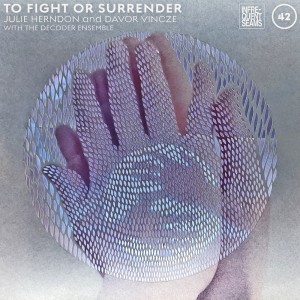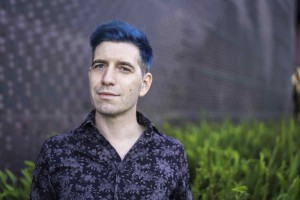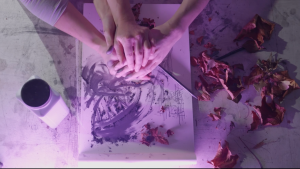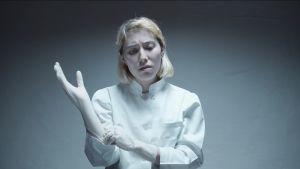
Artist
IMAGES: To download, click above. Photo one image credit: Julie Herndon by Bonnie Rae Mills. Photo two image credit: Davor Vincze by Andrew Watts. Photo three image credit: still from video of At That Time by Heinrich Horwitz. Photo four image credit: still from video of XinSheng by Heinrich Horwitz.
Julie Herndon and Davor Vincze
Infrequent Seams
This pair of audiovisual operas by Julie Herndon and Davor Vincze question the nature of love and manipulation. Each tells the stories of powerful women who must choose at critical moments if they will fight or surrender—and the consequences of those actions. Davor Branimir Vincze’s “XinSheng,” speaks of the present, or perhaps the near future, and is set in a quasi-dystopian world of tangled relationships, cutthroat competition, and medical malpractice. Julie Herndon’s “At That Time,” draws its narrative from history, presenting a richly nuanced retelling of the lives of modernist writer Gertrude Stein and her partner Alice B. Toklas. But while these two works diverge in their choice of subject matter, they also converge around common themes, including the clash of personal feelings with professional obligations, the sacrifices demanded by love, and the paradoxical intersections of intimacy and distance.
The works were directed by Heinrich Horwitz and performed by the Decoder Ensemble: Leopold Hurt, Carola Schaal, Sonja Lena Schmid, Jonathan Shapiro, and Sebastian Berweck, with soloists Jessica Aszodi and Nina Guo. The works were curated by the artistic director and composer Margareta Ferek Petrić for the Zagreb Music Biennale, with video by Heinrich Horwitz (director), Lara Rodriguez Cruz, and Jule Katinka Cramer and audio recorded by Anne Taegert and Carlo Grippa, mastered by Christopher Botta.
“XinSheng” concerns a tangled love triangle between Andrei, a boxer, Fan, his coach, and Anne, a surgeon. After Andrei barely survives an underground boxing match in a parking garage, Fan pressures Anne to treat him using an experimental drug, “XinSheng,” which will save his life but at a grievous cost. As the opera proceeds and we learn more about the complicated histories of its characters, it grows increasingly difficult to know whether Fan’s desire to save Andrei is motivated by affection, professional duty, or her own financial gain. At the same time, as the stakes of Anne’s decision to administer or withhold the drug are revealed, it becomes unclear whether her final choice represents a gesture of love or of revenge. Ultimately, perhaps it is both—an act of love that is itself a form of violence.
Like its narrative, the music of “XinSheng” veers between extremes. Its opening minutes, which depict Andrei’s near-fatal fight, are visceral, bringing fluttering and growling instrumental textures together with the sounds of panting and gasping to create the sound of a body in crisis. Throughout the fight sequence, the music remains unrelentingly violent, full of bass drum pulses that evoke the sound of Andrei’s racing heartbeat and shrieking cello glissandos that suggest the cries of the onlookers. Later, as the drama of Andrei’s fight is supplanted by the drama of his treatment, the music becomes more distant and ethereal. As surgeon Anne stands over Andrei’s body, her reflections on the debt she owes his coach Fan—and indeed, the debt Fan owes her—are expressed in a beautiful cascade of descending vocal lines, accompanied by celestial synthesizer textures and sparse zither dissonances. As she slowly comes to her decision, the musical texture grows denser and thicker, culminating in an almost unbearable moment of intensity before collapsing, seemingly in exhaustion, into a field of faint, hollow harmonies punctuated by bright pinpoints of sound. Depending on how we understand her choice, this eerie wash of texture could be heard as a reprieve from the violence endured earlier or as its apotheosis.
“At That Time” takes up the similarly complex relationship of Gertrude Stein and Alice B. Toklas. This opera’s libretto assembles fragments from two books: The Autobiography of Alice B. Toklas—a 1933 text which narrates Toklas’s life but was written by Stein, making it an autobiography in name alone—and Stein’s 1937 follow-up Everybody’s Autobiography. The passages that Herndon excerpts from these two books at once attest to the enduring love of Stein and Toklas and hint at the professional sacrifices that Toklas had to make to support her partner: “I am a pretty good housekeeper and a pretty good gardener and a pretty good needlewoman and a pretty good secretary and a pretty good editor and a pretty good vet for dogs and I have to do them all at one and I found it difficult to add being a pretty good author.” But since this narrative is ultimately authored by Stein, it is hard to know whether these seemingly poignant words express Toklas’s own sentiments, Stein’s interpretation thereof, or a complete fabrication. As in “XinSheng,” then, there is no statement here that can be taken at face value: in the end, it is hard to choose between a romantic reading in which Toklas is freely gifting her own voice to Stein or a more cynical interpretation in which Stein is instrumentalizing Toklas’s voice for her own professional goals.
Rather than attempt to smooth over this ambiguity, the music of “At That Time” intensifies it, endlessly refracting and recombining the voices of its two central characters. In the opera’s first movement, the character of Gertrude recounts Alice’s early childhood, chanting her words hypnotically into a vocoder. The resulting texture, a kind of sonic halo effect, evokes the haziness of memory—but at the same time, the fact that the harmonies of the vocoder are being controlled by the keyboard player also raises the question of how much the singer’s voice is her own. The question of who’s really telling the story—and indeed, of who’s who in the first place—continues to resonate throughout the opera. Over a virtuosically understated background of drones, lilting ostinatos, and chaotic but choreographed melodic flourishes, the characters of Gertrude and Alice endlessly pass the same words back and forth: sometimes singing in unison, sometimes echoing one another, and sometimes transcribing one another’s words using a typewriter or scribbling them down with a pencil. At one moment, Alice mirrors Gertrude’s vocal line a couple beats behind her on a clarinet, while a cello follows the two of them even further behind, creating a rich and uncanny cascade of wordless echoes. This moment—like the whole opera—is at once beautiful and uncomfortable, reminding us of the impossibility of separating out the voices of its characters, composer, and performers.
One of traditional opera’s many paradoxes is that although it is a genre deeply concerned with human interiority and intimacy, it cannot depict these without expanding them to inhuman proportions. The necessities of opera’s form demand that even the smallest expressions of emotion are infinitely magnified: even while its performers are supposedly alone onstage, murmuring secrets to confidants or whispering sweet nothings to lovers, they are also belting these out to an audience of hundreds or thousands listening in from the darkness of the hall. In video operas like the two presented on this album, this paradox can be resolved using the camera, which brings us up close to the performers, allowing us to hear their whispers and to see tiny flashes of feeling pass over their faces. But even as it does so, the camera also reminds us of our distance from the performers, emphasizing the fact that rather than perform live for us, they are speaking to us through the medium of the screen.
As well as compelling narratives in their own right, “XinSheng” and “At That Time” can be heard as meditations on these problems of intimacy and distance inherent to their medium. “XinSheng,” in its close-ups of Andrei’s bloodied face and close-miked pants, gasps, and snarls of anger, emphasizes that intimacy can be distancing: the closer the opera gets to its characters, the more impersonal and uncomfortable it becomes. “At That Time,” meanwhile, gives us moments of distance that paradoxically produce intimacy, retreating in its most touching moments from its characters’ faces to show only their intertwined hands or the movement of their shadows. The concluding minutes of this opera beautifully sum up this paradox: Alice, recounting her love for airplanes, sings that it is precisely when she leaves the earth behind that she realizes how closely she is tied to it. It is when we view the world from afar, she says, that it becomes “completely that thing…that itself and what you see when you are looking.”
— Gabriel Ellis





